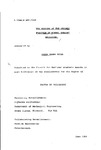THE ORIGINS OF THE ORGANIC FRACTION IN DIESEL EXHAUST EMISSIONS
| dc.contributor.author | TRIER, COLIN JAMES | |
| dc.contributor.other | School of Engineering, Computing and Mathematics | en_US |
| dc.date.accessioned | 2013-10-22T11:36:54Z | |
| dc.date.available | 2013-10-22T11:36:54Z | |
| dc.date.issued | 1988 | |
| dc.identifier | NOT AVAILABLE | en_US |
| dc.identifier.uri | http://hdl.handle.net/10026.1/2288 | |
| dc.description.abstract |
Diesel exhaust particulates are the subject of increasingly severe legislation controlling mass emissions throughout the world. Other emissions, which are currently unregulated, are also receiving closer scrutiny. In particular, polycyclic aromatic compounds (PAC), some of which are known carcinogens, are being studied. A total exhaust solvent scrubbing apparatus (TESSA) has been constructed to sample diesel exhaust hydrocarbons, using a solvent mixture to strip organic compounds from exhaust gases. This avoided adsorption of hydrocarbons onto particulates, when fitted close to the exhaust port, and minimised the formation of sampling artifacts. TESSA yielded new information, enabling lighter more volatile organics such as 2- and 3-ringed PAC to be characterised, these could not be collected by a dilution tunnel filter, which trapped particulates effectively but did not sample the hydrocarbons which had remained in the gas-phase. TESSA has proved itself to be uniquely suitable for the sampling of gaseous hydrocarbons with which there is currently an increased interest. Experiments using TESSA have confirmed that there is a contribution to the exhaust from small amounts of fuel passing through the combustion chamber substantially unchanged, as well as from partially burnt or pyrolysed products of combustion. New techniques have been developed to aid the interpretation of data obtained from high resolution gas chromatography and gas chromatography/mass spectrometry, in order to assess the origin of specific groups of compounds within the highly complex samples obtained from diesel exhaust. Naphthalene and phenanthrene were shown to increase their concentration relative to their alkylated derivatives in an exhaust sample when compared to the relative concentrations found in the fuel. These parent compounds were being formed within the combustion chamber, as well as surviving in unburnt fuel. Nitro-PAC were detected only at considerably lower concentrations than had previously been found on dilution tunnel filter samples. Two new methods for assessing the contribution of lubricating oil to diesel exhaust emissions have been developed, and involved matching common peaks in a sample and a lubricating oil standard. The results demonstrated that lubricating oil makes a significant contribution to the total particulates. Increased control of lubricating oil leakage to the exhaust would help to reduce particulate emissions to below the new stringent limits. | en_US |
| dc.description.sponsorship | Perkins Engineering, Peterborough | en_US |
| dc.language.iso | en | en_US |
| dc.publisher | University of Plymouth | en_US |
| dc.title | THE ORIGINS OF THE ORGANIC FRACTION IN DIESEL EXHAUST EMISSIONS | en_US |
| dc.type | Thesis | |
| dc.identifier.doi | http://dx.doi.org/10.24382/1557 | |
| dc.identifier.doi | http://dx.doi.org/10.24382/1557 |
Files in this item
This item appears in the following Collection(s)
-
01 Research Theses Main Collection
Research Theses Main


